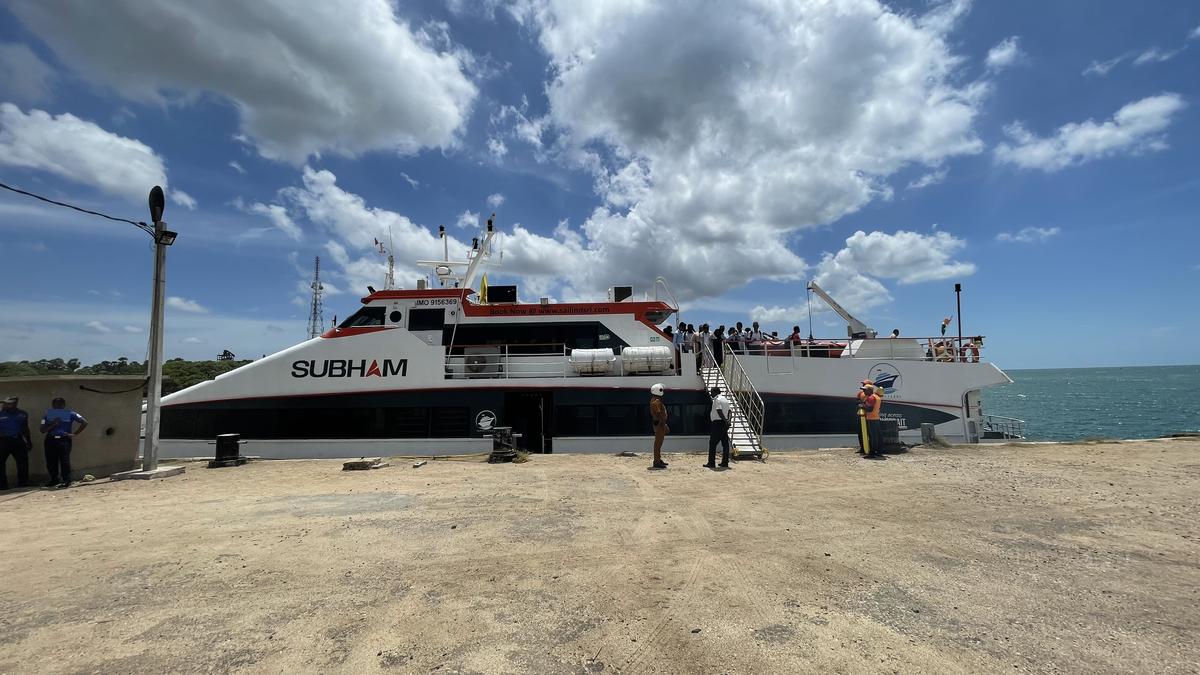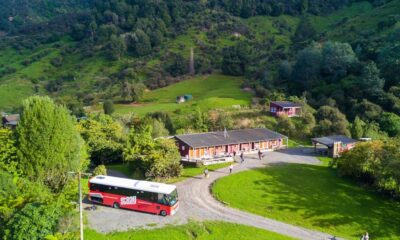On a cloudy September morning, five childhood friends in their late 60s gathered at Nagapattinam port in Tamil Nadu, their laughter cutting through the sea breeze. For over four decades, they had traveled across India together, but that day was different. They were boarding the Nagapattinam-Kankesanthurai ferry between India and Sri Lanka for the first time. When asked the purpose of their visit, retired headmaster, C. Sugumaran, who was part of the group, said with a wide grin, “Just for fun.”
The ferry service had been restarted on October 14, 2023, after a nearly 40-year hiatus. In video messages, Prime Minister Narendra Modi and the then Sri Lankan President, Ranil Wickremesinghe, had hailed the diplomatic effort and highlighted the importance of launching the service between the two nations. Calling it a “new chapter in diplomatic and economic ties between India and Sri Lanka,” Modi said that the service would help strengthen cultural, commercial, and civilizational ties between India and Sri Lanka. Wickremesinghe said the ferry was an important step in improving connectivity.
However, authorities temporarily suspended service after just a week, citing technical issues and rough weather.
On August 16 this year, service was resumed, with support from the External Affairs Ministry. The demand was initially low, forcing the operator to reduce frequency from seven days to three days a week. When interest grew again, the operator, IndSri Ferry Services Private Limited, added a fourth day. In recent weeks, there has been an encouraging rise in occupancy, with an average of 80 passengers per trip. Ticketing agencies said this was due to positive feedback, largely by word-of-mouth.
A ferry ride to another country
The ferry accommodates 165 passengers and crew and includes 27 premium seats. The price of a ticket is ₹5,000 for economy and ₹7,500 for premium. Passengers are allowed 23 kilograms of luggage for free. They can carry up to 50 kg of luggage by paying ₹50 for every additional kg. The ferry leaves Nagapattinam at 8 a.m. and reaches Kankesanthurai at noon. It leaves Sri Lanka at 2 p.m. and returns to India by 6 p.m.
The captain of the passenger ferry, Sivagangai, was J. Baskar. He explained that the vessel would operate at 18 knots with strict anti-smuggling protocols and would be monitored by authorities from both nations throughout the journey.
“Both sides can inspect the vessel at any time. It is mandatory for us to provide information on all aspects of the journey, including passenger numbers and nationalities, for transparency and security,” Baskar said. He added that the ferry was equipped with life jackets, life rafts, and a rescue boat.
A group of five families in the ferry was excited to explore Sri Lanka’s cultural and historical ties with India. They aimed to visit places connected to the Hindu epic, the Ramayana.
S. Shanthi, who was traveling with her husband and son, was delighted. “We are going to see the land where Sita (from the Ramayana) was imprisoned,” she said.
The same day, R. Sugitha, a librarian from Jaffna in the Northern Province of Sri Lanka, used the ferry service to travel to Tamil Nadu. She said it offered a more affordable alternative to flying. “Traveling by air costs 60,000-70,000 Sri Lankan rupees (₹12,000-16,000), but the ferry is only 31,000 rupees (₹8,600) to go across the Palk Strait and come back,” she said.
During the journey, Sugitha and her fellow passengers formed a WhatsApp group called ‘Ship Friends’. They promised to stay in touch after the journey ended.
Reflecting on her return from Sri Lanka, Shanthi said, “We visited temples and saw remnants of the war. But what stood out was the warmth of the local Tamils who treated us not as visitors, but as family.”
While the passengers enjoyed the ride, they also had suggestions for improvement. “While most of the trips are smooth, rough seas can occasionally cause bumpy rides. A larger ferry could provide a more comfortable experience in such conditions,” noted a senior crew member.
Prabhakaran V., an environmental activist from Chennai, who was traveling with his wife, Akshaya, said that the couple had originally planned to go to Sri Lanka for their honeymoon, but the delay in resuming the service had forced them to delay their visit.

Passengers en route to Kankesanthurai, Sri Lanka, from Nagapattinam, India.
| Photo Credit:
Nacchinarkkiniyan M.
“There could be more food options,” Prabhakaran complained, referring to the packets of instant noodles and ready-to-eat food that were available for purchase in the ferry. “They could also offer better amenities at the ports, a smoother connection to Jaffna, and a help desk for the elderly at the Kankesanthurai terminal.” Jaffna is located 21 kilometers from the port. As buses are rare, auto rickshaws are the only mode of transport to the capital city of the Northern Province.
Many traders said that while the service is useful, the baggage allowance could be increased to at least 100 kg per passenger. F.A. Rohan, a trader from Colombo, imports ready-made garments from Tamil Nadu using the ferry service. Despite the relatively low fares for the ferry, Rohan said that the margins in his trade are thin, and he would have to save as much on travel costs. “More baggage allowance would help,” he said.
Rohan also felt that the immigration process in India was time-consuming and the officers unfriendly.
Historical connections
The links between India and Sri Lanka are historical. Writer and publisher K. Sachithananthan noted that the Tamil text, Chola Mandala Sathagam, refers to a famine in Jaffna in the 13th century. “Sadayappa Vallal, the patron who supported Kambar in writing the Tamil epic Kambaramayanam, is said to have sent a thousand boats of rice to the king of Nallur in Jaffna,” he said.
Sachithananthan highlighted the flourishing tobacco trade via the Kankesanthurai port, which thrived until the 1950s, especially with Kerala. The Jaffna Malayalam Tobacco Exporters Association played a key role in this trade, he added.
R. Kulasingam, a Tamil writer from Paruthithurai in Jaffna, explained the significance of the ports of the Northern Province, such as Kankesanthurai, Oorkavalthurai, Paruthithurai, and Valvettithurai. His grandfather, a ‘Thangayal’ (sailor) on the Paruthithurai-Nagapattinam route, witnessed the region’s prosperity, he recalled. However, former Sri Lankan Prime Minister S.W.R.D. Bandaranaike’s nationalization efforts led to the shutdown of many operations, he said.
Highlighting the region’s shipbuilding history, B. Meenakshi Sundaram, son of a shipbuilder from Valvettithurai in Jaffna, spoke of the prominence of these areas in producing skilled sailors. His father built the ship, Parvatha Pathini, during British rule, which was later sold to Pakistan. Though smuggling increased after the ports ceased functioning, Sundaram said many sailors from these areas continue to work globally, keeping the legacy of their craftsmanship alive.
The British, too, established formal transport links between India and Sri Lanka. In the late 1880s, the Boat Mail Express connected Talaimannar and Rameswaram through a collaboration between the Sri Lankan and Indian Railways, allowing for seamless travel and the movement of goods. Under British colonial rule, Indian Tamils, known as ‘hill country Tamils’, were brought to Sri Lanka to work in plantations and built much of the island nation’s early infrastructure. The ferry service was operational until 1964, when a cyclone wiped out Dhanushkodi on the southern tip of Pamban island in Tamil Nadu, shifting the route to Rameswaram. The service continued until the Sri Lankan civil war in 1983 forced its suspension. In 2011, an attempt was made to revive the Thoothukudi-Colombo ferry service, but it was short-lived.
S. Rathinamani Ammal, 88, from Matale in the Central Province of Sri Lanka, fondly recollected over a phone call her journey on the ferry in 1965, from Talaimannar on the northwestern coast of Mannar Island to Rameswaram in the Ramanathapuram district of Tamil Nadu. She spent 10 days at her ancestral home in Karaikudi and visited temples in Srirangam and Madurai.
“If the rice cooked at home in Matale was packed in leaves, it would still be hot when we landed in Rameswaram,” she said. Ammal said that her family would often travel to India to manage their land and pray at temples.

Since then, there have been many efforts to resume the ferry service across the Palk Strait. S. Niranjan Nanthagopan, managing director of IndSri Ferry Services, who has long championed stronger India-Sri Lanka ties, was among those leading the initiative. During colonial rule, Nanthagopan’s ancestors operated ships between Jaffna and Vedaranyam town in Nagapattinam district, transporting passengers and goods.
According to him, tourism can reconnect the Tamils on both sides of the Palk Strait and open up new opportunities. “Connectivity is the first priority,” Nanthagopan said. “Once that is established, other aspirations can follow.”
Economic and strategic ties
Highlighting the need for stronger connectivity between India and Sri Lanka, Sai Murali S., the Consul General of India in Jaffna, explained that the Indian government has been covering part of the costs of the ferry service. “The aim is to lower user costs and strengthen bilateral ties,” he said.
The Sri Lankan government plans to expand the Jaffna International Airport and introduce new routes to Tamil Nadu and diaspora hubs. Sai Murali said that the Indian government would also bear part of the costs of the expansion of the airport. Thanks to the success of the Chennai-Jaffna route by air, there are now IndiGo flights between India and Sri Lanka every day.
“India will also be managing renovation costs at Kankesanthurai port; work is set to begin this year,” he said. “Prime Minister Modi’s vision includes restoring the Talaimannar-Rameswaram route too. There are feasibility studies underway to reconstruct the ancient land bridge between Dhanushkodi and Talaimannar, with India covering most of the cost.” Sai Murali added that discussions are also ongoing with more ferry operators to pitch in and also to improve the quality of service between Kankesanthurai and Nagapattinam. Passenger feedback is expected to help the authorities resolve issues.
K.D.S. Ruwanchandra, Secretary of Sri Lanka’s Ministry of Ports, Shipping, and Aviation, acknowledged India’s vital role in enhancing connectivity. A bilateral committee oversees ferry operations, though challenges remain, especially in securing vessels with cargo capacity.
“We have implemented security measures at Kankesanthurai port. Customs and immigration officers are working alongside Sri Lanka’s Ports Authority security and Naval officers,” Ruwanchandra said, stressing the importance of preventing illegal activities.
A boon for the Tamil community
Sri Lankan Tamil refugees in India said they prefer the ferry over flights as it has a larger cargo capacity. R. Manikandan, 25, was born in the Devakottai special camp in Sivagangai district in Tamil Nadu as a refugee. He recently returned to Sri Lanka by the ferry and obtained citizenship for the first time in his life. “I felt a deep connection. Everything seemed so near, both physically and emotionally,” he said.
The ferry service has been hailed as a boon for the Tamil community. M. Piiratheepan, an Acting District Government Agent in Jaffna, highlighted the deep cultural and spiritual ties between India and Sri Lanka. He emphasized plans to create a tourist-friendly environment with proper facilities, including information centers and support for hotels and guides.
R. Jeyasekaran, President of the Jaffna Chamber of Commerce, stressed the need for improving the ferry service and introducing cargo services. “India could supply 75% of our daily needs, which would reduce our reliance on China,” he said. Jeyasekaran explained that a 500-tonne cargo ship could lower costs, expand Jaffna’s market, and reduce dependence on Colombo.
S. Narasimman from the India-ASEAN-Sri Lanka Chamber of Commerce and Industry, added, “We are very watchful of the ferry development. While the current patronage appears to be low, the introduction of a cargo service in the near future could certainly capture our attention.”
Skepticism and concern
However, fisherfolk on both sides were skeptical that relations would improve through the ferry service. Cautiously hopeful about future relations between the Tamil fishermen of Sri Lanka and Tamil Nadu, N.V. Subamaniyam, former president of the Northern Province Fisher People’s Unity, highlighted the impact that India’s bottom trawlers had on Sri Lankan fishermen. “They cut our nets and take away our livelihoods,” he said.
Subamaniyam recalled the time when the fisherfolk from both sides would share food and enjoy camaraderie at sea. “They would watch Tamil movies like Pattikaattu Ponnaiya and Thanga Padhakkam in Rameswaram during the 1970s,” he said. “But those days are long gone.”
R.M.P. Rajendra Nattar, President of the Indian National Fishermen Union, echoed these concerns. “We face attacks from the Sri Lankan Navy and our government remains silent when our boats are seized,” he said. Despite the challenges, Nattar stressed that Indian fishermen bear no ill will towards Sri Lankan fishermen, as many of them continue to struggle post-war.
Ahilan Kadirgamar, senior lecturer at the University of Jaffna in Sri Lanka, welcomed the renewed connectivity but emphasized that it is only part of a more complex picture. While Tamil Nadu’s economy has flourished, Jaffna remains largely rural, he noted. “Will Jaffna truly benefit from this economic relationship or merely become a market for Indian goods, which will undermine local production?” he said.
Kadirgamar was also worried about how tourism would impact the fragility of the region, and the potential over-reliance on India. “The Northern Province is now viewed through New Delhi’s strategic lens,” he said. “The India-Sri Lanka relationship is increasingly centered on security and geopolitics rather than cultural ties.”
nacchinark







































